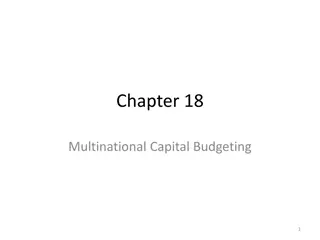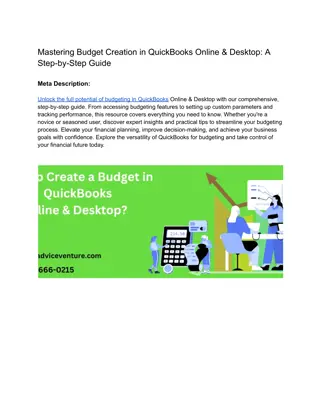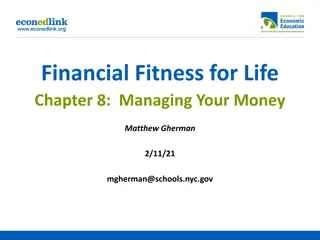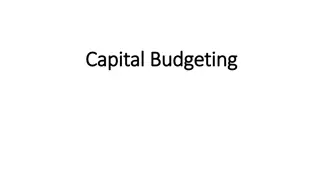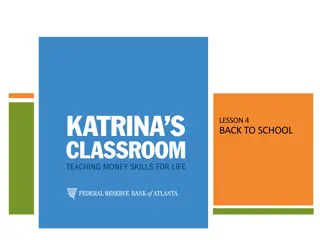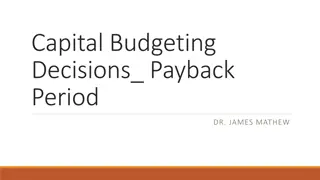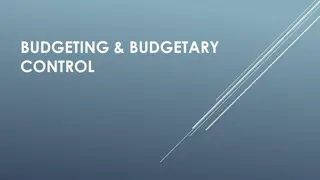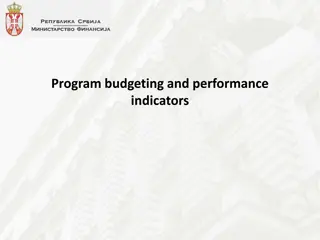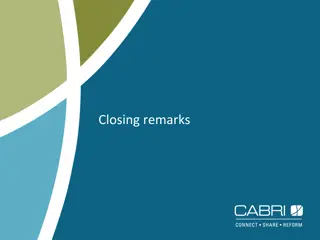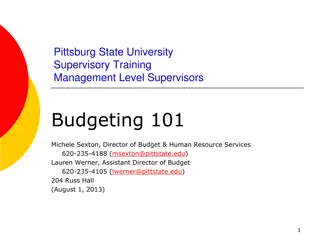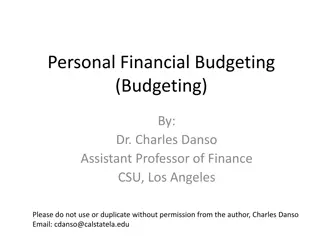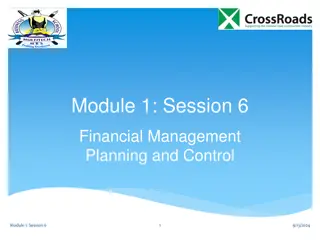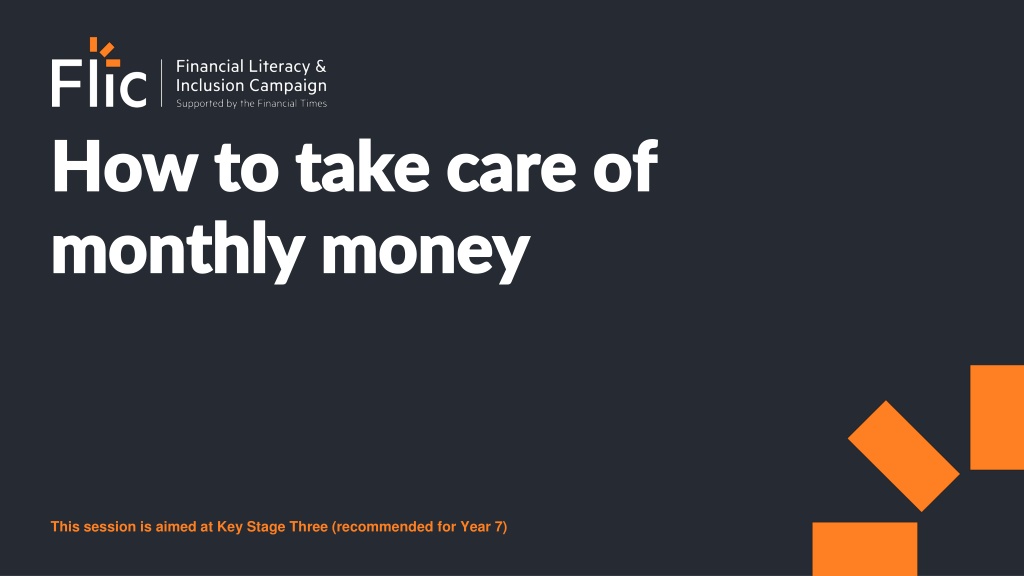
Essential Skills for Managing Monthly Finances
Learn how to effectively manage monthly money by understanding budgeting, spending decisions, and the impact of inflation. This session is ideal for Key Stage Three students and covers topics such as setting budgeting goals and analyzing income and expenses. Gain essential skills for financial planning and creating a respectful learning environment.
Download Presentation

Please find below an Image/Link to download the presentation.
The content on the website is provided AS IS for your information and personal use only. It may not be sold, licensed, or shared on other websites without obtaining consent from the author. If you encounter any issues during the download, it is possible that the publisher has removed the file from their server.
You are allowed to download the files provided on this website for personal or commercial use, subject to the condition that they are used lawfully. All files are the property of their respective owners.
The content on the website is provided AS IS for your information and personal use only. It may not be sold, licensed, or shared on other websites without obtaining consent from the author.
E N D
Presentation Transcript
How to take care of How to take care of monthly money monthly money This session is aimed at Key Stage Three (recommended for Year 7)
Unit outline Session 1 Session 2 Session 3 Session 4 Session 5 Session 6 Spending decisions The impact of inflation The critical consumer Budgeting for a holiday Budgeting Getting a job
Having a respectful learning environment We will listen to each other respectfully We will avoid making judgements or assumptions about others We will comment on what has been said, not the person who has said it We won t put anyone on the spot and we have the right to pass We will not share personal stories or ask personal questions If there is a question that you do not wish to ask aloud, you can write it on a Post-it Note which will be collected throughout the session and answered at the end
Session 2: Budgeting Budgeting
By the end of the session, I will be able to: Describe what a budget is and why it is important Analyse budgets, looking at income and expenses Set budgeting goals and ways to plan for the future
Starter | Needs vs Wants Recap. Draw a Venn diagram and put the items below into the different categories. Which overlap? Wants Needs 1. 2. 3. 4. 5. Smart phone Paying housing rent Home heating New pair of trainers Stationary (pens, ruler, pencils) Laptop Holiday abroad Cracked screen repair Electricity bills 10. Netflix subscription Home heating Holiday abroad 6. 7. 8. 9.
Budgeting Think - Pair - Share I would love to go to the cinema with my sister. However, I ve now factored in the bus price and the fact that I need to buy my best friend a birthday present, and I don t have enough money in my budget. 1. What is a budget? 2. Why would Charlie budget? 3. How do people budget? Charlie
Budgeting What is a budget? A way of planning finances, taking into account income and expenses. Why budget? Can increase confidence and improve wellbeing A person can feel more in control over their money Understand spending better and where to cutback if needed Allows us to save for the future Provides financial security and safety
How do people budget? There are 2 main things to consider when it comes to budgeting: 1. Income - how much money is available every month 2. Expenditures - payments that need to be made throughout the month. Some of these may be regular, others will vary Then people can see how much left there is to spend on other needs and additional wants, taking into account money they will want to save for the future. Receipts can a be useful way of tracking spending
Digital budgeting tools How might apps be able to help people with budgeting? Watch the video explaining how digital budgeting tools can be used: Digital Budgeting Tools Write down 3 things digital apps allow you to do Terms to consider: spending - saving - goal - awareness - categories - managing money - apps Video: Digital Budgeting Tools
Budgeting - Over to you! I would love to go to the cinema with my sister. However, I ve now factored in the bus price and the fact that I need to buy my best friend a birthday present, and I don t have enough money in my budget. Can you summarise why it s important for Charlie to budget? (2-3 sentences) Stretch: What can Charlie do to save money? Charlie
By the end of the session, I will be able to: Describe what a budget is and why it is important Analyse budgets, looking at income and expenses Set budgeting goals and ways to plan for the future
Karims budget Meet Karim Karim works part time and has put together a list of his income and expenses. He now needs your help to work out whether his budget balances.
Karims budget This is Karim s income and spending for the month. Item Amount Meet Karim Salary (after tax) 1800 Karim has put together a list of his income and expenses. He now needs your help to work out whether his budget balances. Babysitting job 200 Food 200 Travel 50 Household bills 400 Firstly, what do you think we mean by a balanced budget? Weekend activities and eating out 350 Rent 400 New clothes 200 Money remaining Resource 1: Karim s budget worked example
Karims budget This is Karim s income and spending for the month. Item Amount Meet Karim Salary (after tax) 1800 Karim has put together a list of his income and expenses. He now needs your help to work out whether his budget balances. Babysitting job 200 Food 200 Travel 50 Household bills 400 A balanced budget is when income (money coming in) is greater than expenses (money going out), with some extra money left over for savings. Weekend activities and eating out 350 Rent 400 New clothes 200 Money remaining Resource 1: Karim s budget worked example
Karims budget This is Karim s income and spending for the month. Item Amount Salary (after tax) 1800 ACTIVITY Babysitting job 200 1. Refer to the list of items on the worksheet and identify which items are income and which are expenses Once you ve done this, categorise the expenses into needs and wants Calculate how much money is left at the end of the month Food 200 2. Travel 50 Household bills 400 3. Weekend activities and eating out 350 Rent 400 New clothes 200 Money remaining Resource 1: Karim s budget worked example
Karims budget This is Karim s income and spending for the month. ACTIVITY Item Amount 1. Refer to the list of items on the worksheet and identify which items are income and which are expenses Once you ve done this, categorise the expenses into needs and wants Calculate how much money is left at the end of the month Salary (after tax) 1800 2. Babysitting job 200 3. Food 200 Salary income Babysitting job income Food expenditure Travel expenditure Electricity bills expenditure Weekend activities expenditure Rent expenditure New clothes expenditure Travel 50 Household bills 400 Weekend activities and eating out 350 Rent 400 New clothes 200 Money remaining Resource 1: Karim s budget worked example
Karims budget This is Karim s income and spending for the month. ACTIVITY Item Amount 1. Refer to the list of items on the worksheet and identify which items are income and which are expenses Once you ve done this, categorise the expenses into needs and wants Calculate how much money is left at the end of the month Salary (after tax) 1800 2. Babysitting job 200 3. Food 200 Salary income Babysitting job income Food expenditure needs Travel expenditure needs Electricity bills expenditure needs Weekend activities expenditure wants Rent expenditure needs New clothes expenditure wants Travel 50 Household bills 400 Weekend activities and eating out 350 Rent 400 New clothes 200 Money remaining Were yours categorised differently? If so, what is your thinking? Resource 1: Karim s budget worked example
Karims budget This is Karim s income and spending for the month. ACTIVITY Item Amount 1. Refer to the list of items on the worksheet and identify which items are income and which are expenses Once you ve done this, categorise the expenses into needs and wants Calculate how much money is left at the end of the month Salary (after tax) 1800 2. Babysitting job 200 3. Food 200 Travel 50 Household bills 400 Total money remaining = Total income - Total expenditures Weekend activities and eating out 350 = ( 1800+ 200) - ( 200+ 50+ 400+ 350+ 400+ 200) = 2000 - 1600 Rent 400 = 400 New clothes 200 Money remaining 400 Resource 1: Karim s budget worked example
Budgeting deep dive Read through Part A and answer the questions on your worksheet 5 mins) As you are working through, write down any questions you have and put them in the classroom anonymous box. Stretch - are some items more difficult to categorise into needs and wants than others? If so, why? Resource 2: Lucy s Budget
Lucys Budget Read through Part A and answer the questions on your worksheet (5 mins). 1. 2. 3. 4. 5. 6. Complete the values for total income and total expenses in the table. What is Lucy s biggest monthly expenditure? What is Lucy s smallest monthly expenditure? How much money does Lucy have remaining? Why is it important to have money remaining at the end of the month? What can it be used for? Complete the last column using needs and wants , identifying which expenses and needs and which are wants. What is the total amount she spends on needs? What is the total amount she spends on wants? 1. 2. Stretch - are some items more difficult to categorise into needs and wants than others As you are working through, write down any questions you have and put them in the classroom anonymous box. Resource 2: Lucy s Budget
Lucys Budget ANSWERS Read through Part A and answer the questions on your worksheet (5 mins). Complete the values for total income and total expenses in the table Please see table What is Lucy s biggest monthly expenditure? Flat rental What are Lucy s smallest monthly expenditures? Cinema trips and other outings AND Streaming subscription How much money does Lucy have remaining at the end of the month? 2,400 - 2,060 = 340 Why is it important to have money remaining at the end of the month? What can it be used for? It can be used to save for the future, e.g. a bigger life goal such as expenses for university, a car or mortgage for a home. It can also be used to invest to try and make the money grow further. The money could also be used if there is an unexpected event such as a house leak, which needs fixing. Complete the last column using needs and wants , identifying which expenses and needs and which are wants. Are there any which are hard to categorise? Examples include gym membership or mobile phone. Gym membership - may be important for staying healthy but could Lucy workout outdoors instead which doesn t cost? Mobile phone - the latest smartphone may be a want but a more basic phone may be a need. These will depend on peoples values and priorities. What is the total amount she spends on needs? 1,380 8. What is the total amount she spends on wants? 680 1. 2. 3. 4. 5. 6. 7. Resource 2: Lucy s Budget
Transactions Income Amount Expenses Expenses Needs or wants? Graphic designer 2,100 Flat rent 900 N Saturday job - waitressing in a cafe 300 Electricity and gas 120 N Cinema trips and other outings 30 W Streaming subscription 30 W New work clothes and shoes 200 W Gym membership 40 W Mobile phone 50 N Petrol 140 N Dog food 40 N Supermarket food 80 N Council tax 50 N Holiday weekend away to Paris 280 W Restaurants 100 W Total income Total expenses 2,400 2,060
A guide to help budgeting A guide to help budgeting Needs 20% Wants Future (savings, investments and rainy day fund) 50% 30%
Applying the 50:30:20 rule This is Karim s income and spending for the month. Item Amount Revisiting our budget, can we apply the 50:30:20 rule to work out how balanced Karim s budget is? Salary 1800 Babysitting job 200 How could we do this? Think - Pair - Share Food 200 Travel 50 Household bills 400 Reminder: 50:30:20 rule for income Weekend activities and eating out 350 Rent 400 50% on needs 30% on wants 20% on savings New clothes 200 Money remaining 400
Applying the 50:30:20 rule This is Karim s income and spending for the month. Item Amount Revisiting our budget, can we apply the 50:30:20 rule to work out how balanced Karim s budget is? Salary 1800 Babysitting job 200 To do this, we need to calculate the percentage of his expenses that are spent on wants, needs and the percentage of money remaining for the future. Food 200 Travel 50 Household bills 400 Weekend activities and eating out 350 Rent 400 New clothes 200 Money remaining 400
Applying the 50:30:20 rule This is Karim s income and spending for the month. Item Amount Revisiting our budget, can we apply the 50:30:20 rule to work out how balanced Karim s budget is? Salary 1800 Babysitting job 200 Food 200 To do this, we need to: Travel 50 Step 1: Calculate 50%, 30% and 20% of Karim s income to calculate the ideal amount he should spend on needs, wants and save for the future Household bills 400 Weekend activities and eating out 350 Step 2: Compare how much he should with how much he actually did spend on needs, wants and the future Rent 400 New clothes 200 Money remaining 400
Applying the 50:30:20 rule This is Karim s income and spending for the month. Step 1: NEEDS - 50% Item Amount Needs vs Wants Salary 1800 Income We are going to compare the ideal amount with the actual amount. Babysitting job 200 Income Step 1: Calculate ideal amount spent on needs 50% of his total income is 0.50 x 2,000 = 1,000 To find 50%, we can also find 10% and multiply that by 5. 10% of 2,000 = 200 200 x 5 = 1,000 Food 200 Needs Travel 50 Needs Household bills 400 Needs Weekend activities and eating out 350 Wants Step 2: Compare actual amount spent on needs He actually spent 200+ 50+400+ 400 = 1,050 Rent 400 Needs New clothes 200 Wants What do you notice? Stretch - what percentage of Karim s budget was actually spent on needs? Money remaining 400 Resource 1: Karim s Budget Worked Example
Applying the 50:30:20 rule This is Karim s income and spending for the month. Step 2: WANTS - 30% Item Amount Needs vs Wants Salary 1800 Income We are going to compare the ideal amount with the actual amount. Babysitting job 200 Income Step 1: Calculate ideal amount spent on wants 30% of his total income is 0.30 x 2,000 = 600 To find 30%, we can also find 10% and multiply that by 3. 10% of 2,000 = 200 200 x 2 = 600 Food 200 Needs Travel 50 Needs Household bills 400 Needs Weekend activities and eating out 350 Wants Step 2: Calculate actual amount spent on wants He actually spent 350 + 200 = 550 Rent 400 Needs New clothes 200 Wants What do you notice? Stretch - what percentage of Karim s budget was actually spent on needs? Money remaining 400 Resource 1: Karim s Budget Worked Example
Applying the 50:30:20 rule This is Karim s income and spending for the month. Step 3: FUTURE - 20% Item Amount Needs vs Wants Salary 1800 Income We are going to compare the ideal amount with the actual amount. Babysitting job 200 Income Step 1: Calculate ideal amount spent on future 20% of his total income is 0.20 x 2,000 = 400 To find 20%, we can also find 10% and multiply that by 2. 10% of 2,000 = 200 200 x 2 = 40 Food 200 Needs Travel 50 Needs Household bills 400 Needs Weekend activities and eating out 350 Wants Step 2: Calculate actual amount of money remaining for the future 400 rent 400 Needs New clothes 200 Wants What do you notice? Stretch - what percentage of Karim s budget was actually spent on needs? Money remaining 400 Resource 1: Karim s Budget Worked Example
Do you think Karim has a balanced budget?
Budgeting deep dive Read through Part B and answer the questions on your worksheet. As you are working through, write down any questions you have and put them in the classroom anonymous box. Resource 2: Lucy s Budget
Budgeting deep dive Read through Part B and answer the questions on your worksheet. Using the 50:30:20 budgeting framework 1. (a) What percentage of her total income did she spend on needs in the month? (Total spending on needs total income x 100) (b) Stretch - How does that compare with the recommended proportion? 2. (a) What percentage of her total income did she spend on wants in the month? (Total spending on wants total income x 100) (b) Stretch - How does that compare with the recommended proportion? 3. (a) What percentage of total income did she save in the month? (Total spending on savings total income x 100) (b) Stretch - How does that compare with the recommended proportion? 4. Do you think that Lucy has a balanced budget (meaning is she spending roughly the recommended amounts on needs, wants and savings)? If you were giving some advice to Lucy on the proportion of monthly money she spent on needs, wants and for the future, what would you say to her? (Answer in 2-3 sentences) Resource 2: Lucy s Budget
Lucys budget - Answers | Part B Part B: (a) What percentage of her total income did Lucy spend on needs in the month? (Total spending on needs total income x 100) 1,380 x 100 = 57% 2,400 (b) How does that compare with the recommended proportion? The recommended proportion is 50% so this is close. Perhaps she could look at cutting back slightly on needs or the costs of those needs, e.g. switching supermarkets to get a better deal on her weekly food shop. 1. 2. (a) What percentage of her total income did Lucy spend on wants in the month? (Total spending on wants total income x 100) 680 x 100 = 28% 2,400 (b) How does that compare with the recommended proportion? The recommended proportion is 30% so this is very close. Perhaps she could look at cutting back slightly.
Lucys budget - Answers | Part B 3. (a) What percentage of total income did Lucy save? (Total spending on savings total income x 100) 340 x 100 = 14% 2,400 (b) How does that compare with the recommended proportion? The recommended proportion is 20% so this is not too far off. However, if she can reduce her spending on needs then she can put away more for savings. 4. Do you think that Lucy has a balanced budget (meaning is she spending roughly the recommended amounts on needs, wants and savings)? If you were giving some advice to Lucy on the proportion of monthly money she spent on needs, wants and for the future, what would you say to her? Lucy s budget is well balanced, but there are tweaks that she can make to get closer to the 50:30:20 guidance. Nevertheless, in normal life it is hard to get to these percentages exactly so she has a well balanced budget, where she can cover all of her spending costs and has some money left for savings. Students may wish to explore tweaks that she can make to get even closer to the 50:30:20 rule. Please see some suggestions above.
Discussion 1. How helpful do you think the 50:30:20 rule is? 2. How realistic do you think it is to apply the 50:30:20 rule in everyday life? Budgeting goals are really important to help us plan and feel confident when it comes to how we use our money and being able to afford our needs. However, sometimes people's finances can suddenly change e.g. energy and petrol prices go up, so there is not the desired amount of money left for needs and wants and budgets may need to be adjusted. We want to be sensitive when it comes to money issues as everyone's circumstances are different.
By the end of the session, I will be able to: Describe what a budget is and why it is important Analyse budgets, looking at income and expenses Set budgeting goals and ways to plan for the future
Planning your future How can a person use their savings to plan for the future? Discuss: What do these make you think about? 2 minutes.
Planning your future How can a person use their savings to plan for the future? Savings can be kept in a bank to earn interest* Money can be invested in the hope that it will grow in the future Extra money may need to be spent on unplanned for events. This is known as an emergency fund. *Interest is the cost of borrowing or reward for saving. It is the amount of money that is regularly added to a person s savings account.
Planning your future Think carefully about a personal goal you have e.g. going to university, supporting a family member, owning a car one day or starting your own business. Write your personal goal Stretch - below your goal, write down the main steps you ll need to take to reach it I am going to
Learning Review 2.What might be included in a person s budget? 3. What are some top tips to budget well? 1. What is meant by the term budget ? How will you use what you have learnt in your daily life?
By the end of the session, I will be able to: Describe what a budget is and why a budget is important Analyse budgets, looking at income and expenses and the 50:30:20 rule of budgeting Set budgeting goals and plan for the future
Any questions? Any questions? ?
Services available for people who have concerns about their personal finances Citizens Advice Debt and Money This resource contains links to advice on a number of topics, including financial difficulties, cost of living and communicating with creditors. Childline Helpline 0800 1111 National Debtline Debt and Money a debt advice charity run by the Money Advice Trust, offering a free and confidential debt advice service. At school, you can speak with an adult you trust. This could be your form tutor, head of year or the school s safeguarding officer.
Links to learn more! Articles Articles to extend learning to extend learning Please visit the FLIC Learning Hub for further resources The budget game (NatWest) Budgeting (BBC Bitesize) Cost of living; how children s lives are being affected (Newsround) Newsround speaks to children during winter and a cost of living crisis


